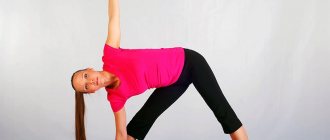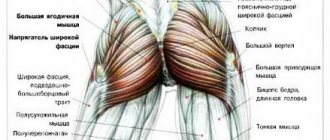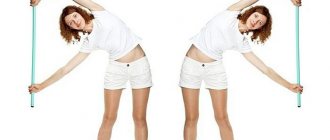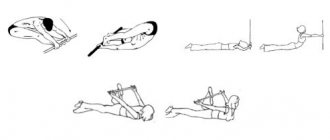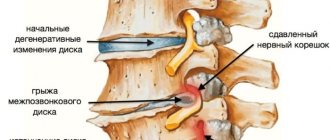Why strengthen your neck muscles?
A developed body always looks harmonious. However, people spend a lot of time on the main muscle groups, often neglecting small ones, such as the neck. The result is healthy men with thin necks. However, the main advantage of strong neck muscles is not the aesthetic component.
Strengthening the neck is useful to reduce the risk of cervical osteochondrosis, reactive arthritis, and reduce the likelihood of injuries when playing contact sports. This is especially true for drivers, office workers and those who have a sedentary job. To reduce the load on the joints and relieve tension, it is worth training it well.
Unloading the neck and shoulder girdle
It is important here which exercises can significantly load the vertebrae in the neck area; these definitely include:
- classic squats (an exercise performed with a barbell lying on the shoulders; the number and weight of plates or weight plates is selected individually);
- hyperextension exercise (exercise with a barbell behind the head);
- weighted bending (an exercise performed with a barbell placed on the shoulders).
The result was a trio of well-known exercises that involve performing certain movements with a barbell on your shoulders. True, a small remark can be made regarding hyperextension: in most cases, this exercise can be included in the training program for osteochondrosis, only a weight limit is imposed. It consists in the fact that the weight is removed completely or is placed not behind the head, but in the sternum area.
In many cases, if you have neck pain, it is not advisable to perform squats with a barbell on your shoulders. In a standing position, there is no critical pressure on the vertebrae of the neck, and at the bottom of a squat this impact becomes strong, which is potentially dangerous and provokes pain. Similarly, the bar puts pressure on the cervical vertebrae when performing other similar exercises. Careless performance of hyperextension or bending with weights can cause deterioration of the spine.
Exercises with a barbell are not contraindicated for people with problems in the cervical spine, but osteochondrosis imposes some restrictions on these exercises. Experts advise abandoning them in case of exacerbation. You can return to these effective exercises when your doctor allows it or when your neck muscles are thoroughly strengthened; we’ll talk about this later.
Indications and contraindications for training
The neck is a very delicate part of our body and requires an appropriate approach. The neck contains the esophagus, larynx, and many blood vessels. The neck muscles and vertebrae provide the head with maximum mobility, many of them are associated with the facial muscles.
You should not do the exercises if you suffer from the following diseases:
- Arterial hypertension.
- High intracranial pressure.
- Diabetes.
- The presence of pathologies and formations.
- Spinal diseases.
- Acute diseases of the cardiovascular system.
You should definitely not start training if you have symptoms of serious diseases of the cervical spine. Therapeutic exercises are applicable for the treatment of mild forms of diseases, but first of all you should consult a doctor so as not to harm your health.
Do I need to download it?
Before answering the question of how to properly pump up your neck, let’s find out for whom this is generally advisable.
Targeted pumping of the neck muscles is not common. We are not talking about physical therapy exercises, but about the additional development of the muscles in this area.
A strong neck is usually needed by wrestlers. Bodybuilders usually do not pay special attention to this part of the body. And this is primarily due to the danger of damaging the spine.
The cervical spine is the most fragile, mobile and weakest place in our spinal column. Damage to it will lead to consequences of varying severity. And it’s very easy to damage your neck – just take too much weight.
If strengthening your neck muscles is important to you, then I'll tell you how to do it safely. But first, pay attention to those points in the presence of which neck training should be limited only to exercise therapy exercises.
Correct technique and types of exercises
Let's say everything is fine with us, and we can start studying. In this case, here is a selection of effective exercises and techniques for performing them:
- Flexion with a pancake. We lie down on the bench with our backs so that our heads hang over the edge. Place a small pancake (or a special disk if you have one) on your forehead and hold it with your hands. We bend our neck trying to touch our chin to our chest and return back to the starting position.

- Extension with a pancake. The principle of the exercise is the same, only we lie on our stomachs and place the pancake on the back of our heads. Holding the pancake with your hands, we successively lower and raise your head.
- Lateral bending on a bench. We lie on our sides, put a pancake on our temple and begin to lift it. After several repetitions, change sides.
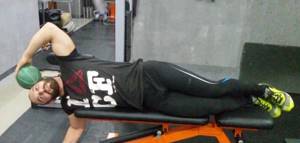
- Bortsovsky Bridge. Cool exercise. We stand in a bridge, resting our heads on the floor and perform bends and repetitions with our necks. You can change the angle. Look at the powerful necks of the wrestlers. All this is due to this exercise. But the exercise is dangerous, and I don’t recommend doing it often.
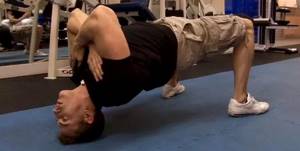
These are all the basic neck exercises. Each of them can be performed with a special helmet, which can be found in the hall. In addition, there are a variety of exercise machines and equipment, but the essence of the exercises is always the same: bend or straighten. I strongly advise you to read the video in order to better understand the specifics of the exercises and not get injured.
If you do not plan to use strength exercises to pump up your large neck, there is a complex of physical therapy (physical therapy), which helps both strengthen the neck muscles and serves as a good preventive measure for diseases of the cervical spine. Its advantage is that there is no need for any hardware. Therefore, it may be of interest to girls and women. It includes exercises:
- Resting your palm on your forehead, we bend back and forth, using your hand to press on your head, creating force.
- With our hands wrapped around our head from behind (as if we were lying on the beach), we bend forward and backward.
- We clasp our neck with our hands and slowly turn it, stretching the muscles (the main thing is not to twist your neck).
The only drawback of the complex is that it is not aimed at shaking the neck. He is focused on treating her. I will not consider the full set of exercises, otherwise the article will be 3 times longer, but if you suffer from mild pain in the neck, I advise you to read it.
For the front of the neck
- touch your chin to your chest, while trying to stretch your neck, reach the top of your head towards the ceiling, do it carefully and slowly;
- raise your head in the direction - with your right ear to the left nipple and vice versa. We do it even more slowly and carefully, trying to feel the nuances of execution;
- exercise “Hello” - slightly raise your head and nod with a small amplitude, literally 2-3 cm, but when nodding, slowly turn your head left and right, as if you were walking through the theater and meeting a bunch of acquaintances, slowly and majestically nod to everyone and say “Hello, hello, hello.” A complete turn of the head, for example, from left to right, will take 15-20 nods;
- raise your head slightly and in this position swallow saliva 4-5 times (at the same time it cures snoring);
- simple turns of the head to the sides, slightly raising the head above the floor (I remind you that we are still lying on our back);
- bends ear to shoulder, still on the back, carefully;
- turn your head to the left and in this position gently stretch your right ear towards the left nipple (you should feel the tension at the other ear). In this exercise the amplitude is very small.
Example workout
In the gym
You can pump up your neck after the main workout, because other muscle groups do not work. If you have trainers or equipment, you can use them. If not, then we work the old fashioned way:
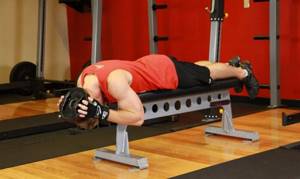
- High-quality cervical gymnastics.
- Flexion or extension with a weight plate 3 x 10-15.
- Bortsovsky Bridge 2-3 sets of 15-20 reps.
- Cool down, a short massage to relax.
I do not recommend doing more than 2 neck exercises in one day, since the muscle group is weak, especially for a city person. In addition, the neck is trained with some basic exercises, such as dumbbell swings, trapezius exercises, and dumbbell rows. Therefore, overexerting it can often be dangerous.
Over time, you can increase the number of repetitions. Exercise No. 2 can be alternated by performing flexion, extension or lateral bending.
At home
You can successfully train your neck at home, even in the absence of any equipment. For classes, we will make a device using a regular towel or an elastic belt. We wrap a towel around our head and hold it by the ends with our hands, creating pressure on the neck muscles, in this position we perform flexion and extension in any direction. Example workout:
- Gymnastics and warm-up.
- Flexion or extension using an elastic belt or towel 3x15-20.
- Bortsovsky Bridge 2-3 approaches 15-20 times.
- Hitch.
For the back of the neck
To strengthen the muscles located on the back of the neck, look at what exercises you can do from those written above, but lying on your stomach. Try carefully and slowly.
People often ask: how many times should I do the exercises? To the point of feeling self-sufficient. This way you will quickly learn to listen to your own body, since the muscle strength of each of us is different and everyone needs their own load.
For example, I do the exercises 10-20 times, and between exercises I don’t put my head on the floor. But it’s not worth repeating right away, I started with a lighter load
